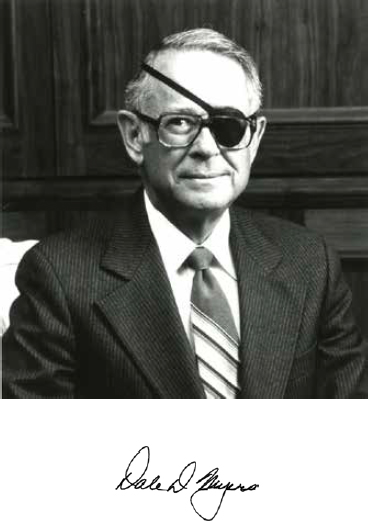This page intentionally left blank.

DALE D. MYERS
1922–2015
Elected in 1974
“Leadership in mastery of space flight and applications of aerospace technology.”
DALE DEHAVEN MYERS died May 19, 2015, in La Costa, California, at age 93. He was born January 8, 1922, to Wilson Alexander Myers, a physician, and Ruth Minerva Myers in Kansas City, Missouri, where he grew up and graduated from Southwest High School. His inspiration for aeronautics was Charles Lindbergh, whom he met at age 5.
Dale attended Kansas City Junior College and then the University of Washington, earning money for his education by working in the Aeronautical Department’s wind tunnel for 50¢/hour. It was an experience that served him well. He graduated with a bachelor of science in aeronautical engineering in 1943.
He went to work as an aerodynamicist at North American Aviation. His first big challenge was using the wind tunnel to find a solution to an unrecoverable inverted spin with the new P-51 Mustang. He solved the problem with a new strake on the airplane.
He progressed to assistant director in the Aerophysics Laboratory, where he worked on the F-82 and studied the application of canards for efficient supersonic flight. The method was used on the Navaho missile, the first Mach 2 turbojet. During this time he lost his left eye in an automobile accident.
He was promoted in 1957 to vice president and program manager of the Hound Dog cruise missile to be used on the B-52. Program management proved to be his real forte, and the Apollo program gave him an opportunity to really shine as manager of the Command and Service Module. Shortly after the successful Apollo 11 mission he began working on the Space Shuttle.
In 1970 he was asked to join the National Aeronautics and Space Administration (NASA) as associate administrator for manned spaceflight, replacing George Mueller. He oversaw the remainder of the Apollo missions, Skylab, and initial planning for the Apollo-Soyuz mission. He also led the studies that defined the Space Shuttle configuration.
He became president of North American Aircraft Operation (now part of Rockwell International) in 1974. He oversaw the B-1 development, testing, and production as well as the fighter and commercial elements of the company, including the work of the Atomics International Division on energy systems.
Government again requested his service in 1977, as undersecretary of the Department of Energy (DOE), where he developed a new budget system and a new program phased authorization system. He also initiated decentralization of project management and a consolidated management information system, and was heavily involved in all high-technology research and development.
He returned to industry in 1979 as president and chief operating officer for Jacobs Engineering Group, a diversified construction company. He worked on the architecture, engineering, and construction of high-technology facilities for the aerospace and electronics industry, and brought in federal programs from the Environmental Protection Agency (EPA), DOE, and NASA. He left the company in 1984 to form his own industry consulting company, Dale D. Myers & Associates Aerospace and Energy.
When President Ronald Reagan asked Dale to serve as NASA deputy administrator after the Challenger accident, he reluctantly agreed. He played a major role in the Shuttle redesign and the return to safe flight, and was a driver in
developing a space station program. He returned to his consulting company in 1989.
In addition to his NAE election in 1974, Dale Myers received numerous awards and recognition, including Distinguished Service Medals from both NASA and DOE. He was an honorary fellow of the American Institute of Aeronautics and Astronautics and a fellow of the American Astronautical Society, and in 2016 he was inducted into the International Air and Space Hall of Fame at the San Diego Air and Space Museum. He also held an honorary doctorate from Whitworth College. After his death the University of Washington remembered him with a plaque and his picture at the wind tunnel where he worked as an undergraduate.
He is survived by daughters Janet Westling (Mike) and Barbara Curtis, five grandchildren, and three great-grandchildren. His wife Marjorie (née Williams) died in 2009.
Janet remembers that her father
found time for fishing, family celebrations, and world travel with his wife (they celebrated 66 years of marriage before she died). He worked for Kistler in his 80s on the recyclable rocket as a consultant. Much of what was learned at Kistler has been picked up by others and the “race to space” continues. He was still giving talks into his 90s. He was infectious and inspirational when it came to anything related to space. His extended family near and far were influenced by him. I’m still learning more about my dad. Now he’s a star in space, and I think of him smiling down on all who follow in his footsteps.
Barbara wrote that her father
married his 19-year-old college sweetheart…. After about 10 years of marriage, Marge thought Dale was working too hard and there was no time for vacations. She suggested they get a small getaway place. He said, “Great; a mountain cabin where I can fish for trout.” She said she had her heart set on a beach cottage. They owned the beach house for more than a half century until Marge got Alzheimer’s. Dale said it was the best investment decision he ever made…. In interviews, Dale
always shared his success in business with his wife, saying there was no way he could have done all he did without her.
Barbara also recalled that when she and other family members attended the Apollo 13 tribute at the San Diego Air and Space Museum, Dale received a standing ovation. Two months later he died of heart failure. He again received a standing ovation when he was inducted into the International Air and Space Hall of Fame in November 2016; she was sorry he was not there for that show of appreciation.






